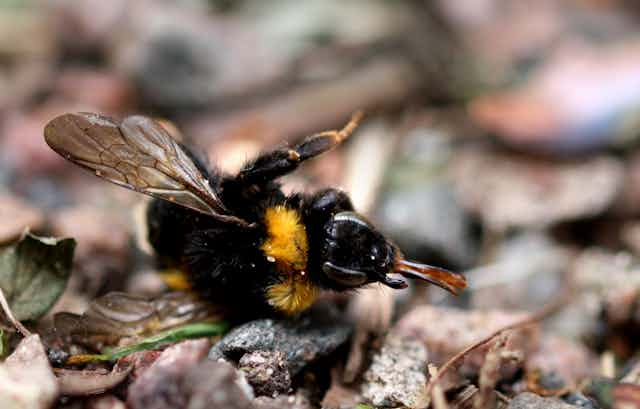The European Parliament voted against a proposal to curb the use of agricultural pesticides in November 2023. These chemicals, designed to protect crop yield from pest insects and other organisms, can contaminate the water and air and threaten the people and wildlife that maintain the vitality of our landscapes.
In some respects, Europe and its governing bodies lead the world in setting and achieving sustainability goals. The EU parliament’s failure to restrict pesticide use stands in contrast to this notion, not to mention international pledges.
Our research shows that efficient use of pesticides in farming will be essential to maintaining the health of bumblebees in particular – one of the most important pollinators of crops and wildflowers.
Lab results v the real world
Decades of laboratory experiments have tested thousands of pesticides to show that they can be individually fatal to bees. Such toxicity tests evaluate the potential harm of these compounds before they are used to inform pesticide regulations.
But do the effects documented in laboratory tests represent what happens when these chemicals are used in the environment? Field-based tests of pesticides are rare and, like laboratory tests, they typically look at single compounds. This is a problem because field-based monitoring has shown that bees are actually exposed to multiple compounds through their foraging across agricultural landscapes.
Many different pesticides, including those highly toxic to bees, have been found in bee bodies, their food and the structures that make up their nests, like wax and soil.
Although it may seem logical to assume that chemicals shown to be toxic in the lab will have similar effects in the field, we know that where chemicals end up and persist in the environment varies and that the impact on bees can differ depending on numerous social and ecological factors.

Until now, it was unclear how exposure to multiple pesticides across landscapes affected how pollinators grow, survive and reproduce. Our new work shows that this real-world exposure significantly threatens the health of bumblebees.
Colonies at risk
We placed over 300 commercially-reared bumblebee colonies at 106 sites on farmland in eight European countries. We collected pollen samples from the colonies and screened them for 267 pesticides.
We found that the pollen that bumblebees collected and stored in their nests was contaminated with multiple pesticides, an average of eight different compounds per colony – the most contaminated colony contained 27 different compounds. We calculated the risk posed by pesticides to each colony by accounting for the amount and toxicity of different pesticides found in their pollen.
We also tracked the performance of bumblebee colonies by weighing them before, during and after they were deployed in agricultural landscapes and by counting all the bees at the end of the experiment.
Colony growth, measured as the change in a colony’s weight over time, was lower in colonies with a higher pesticide risk. Bumblebees also produced fewer offspring in these colonies than in those with a low pesticide risk. These effects were worse in landscapes with lots of cropland, demonstrating the importance of semi-natural habitats and other flower-rich areas for pollinator populations.

To protect pollinators, a proposal from the European Food Safety Authority would ensure that bumblebee colonies do not lose more than 10% colony strength, measured as the number of bees in a colony, due to pesticide use. Yet, over the course of our study, 64% of the bumblebee colonies we studied lost more than this compared to colonies in the least risky places.
Despite having among the most stringent pesticide regulatory processes in the world, our study showed that the EU is failing to protect the organisms these chemicals are not supposed to target, like bees.
Monitor pesticides like drugs
The proposal struck down in late 2023 may go for a second reading in the European Parliament. But with 299 MEPs having previously voted against it, we are not optimistic about its chances. Instead, we draw hope from ongoing efforts to improve environmental risk assessments of farming chemicals and developments at COP28, the most recent UN climate change conference in Dubai.
Pesticide risk assessments can benefit from lessons learned regulating pharmaceuticals. Like pesticides, pharmaceuticals undergo pre-approval testing with phased pre- and clinical trials before they are licensed for use. But once a drug has been licensed, long-term monitoring safeguards against unexpected effects when used at scale. This type of post-approval monitoring under real-world conditions is urgently needed for pesticides.
This shouldn’t replace pre-approval testing. Our experience has simply shown that pesticides that clear laboratory tests, such as neonicotinoids, are only revealed to be harmful through post-approval field testing using bees other than honeybees, which are unusual for their large colony sizes and complex social behaviour. Our approach for monitoring pesticides and their effects on non-target species could be part of future pollinator risk assessments.

Of course, it would be better to change the way pesticides are used in agriculture altogether and lessen the demand on farmers to use them. We are tentatively optimistic about commitments made at COP28, including a US$17 billion fund to develop methods of farming that are resilient to climate change and less reliant on chemicals.
One of the largest initiatives, with partners including The Nature Conservancy, Google, and the Brazilian state of Para, would encourage regenerative farming practices, such as reduced tillage and lower pesticide use.
This, we hope, is progress.

Don’t have time to read about climate change as much as you’d like?
Get a weekly roundup in your inbox instead. Every Wednesday, The Conversation’s environment editor writes Imagine, a short email that goes a little deeper into just one climate issue. Join the 30,000+ readers who’ve subscribed so far.

